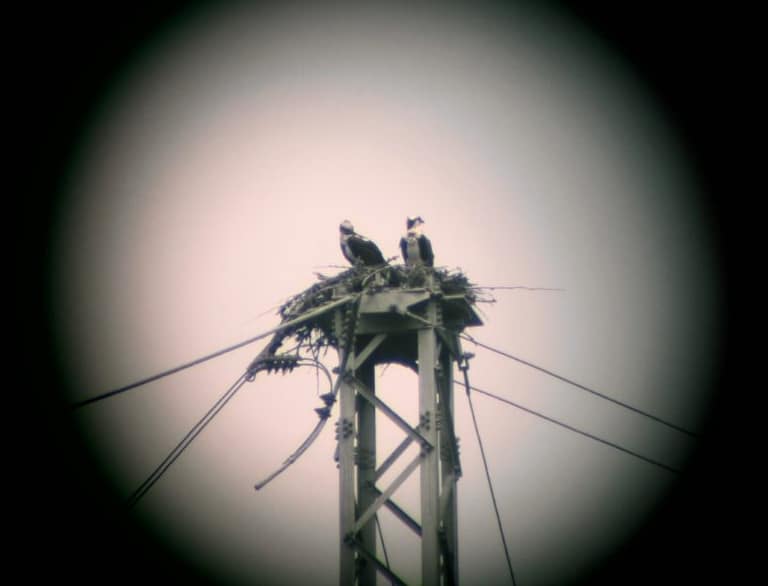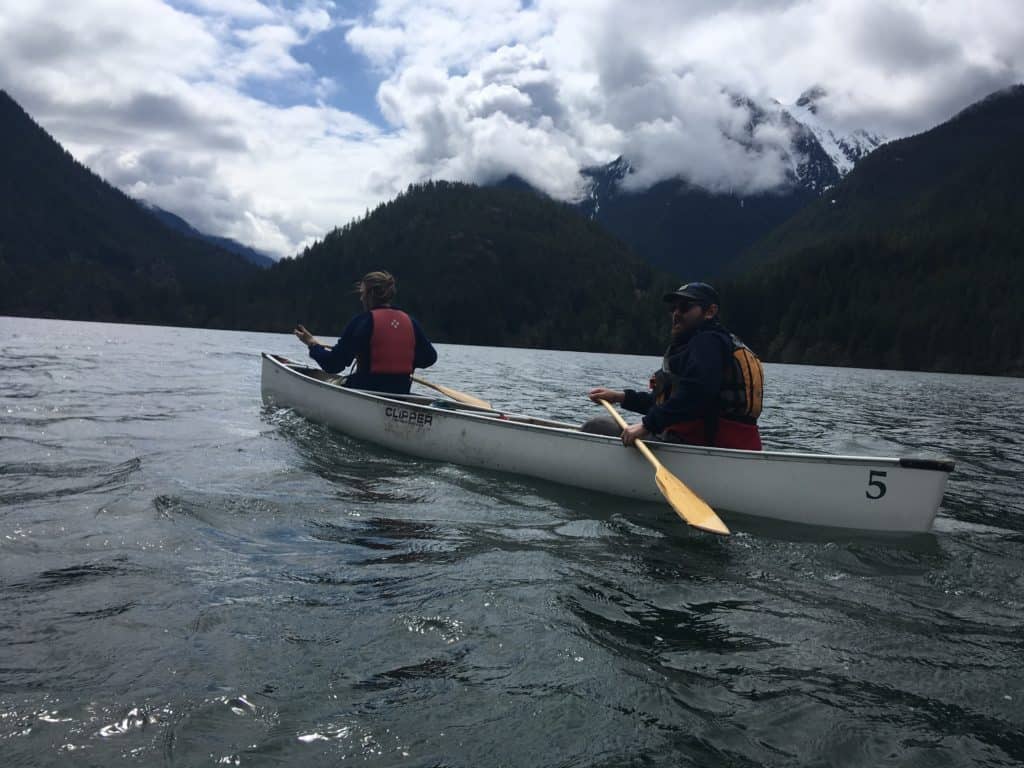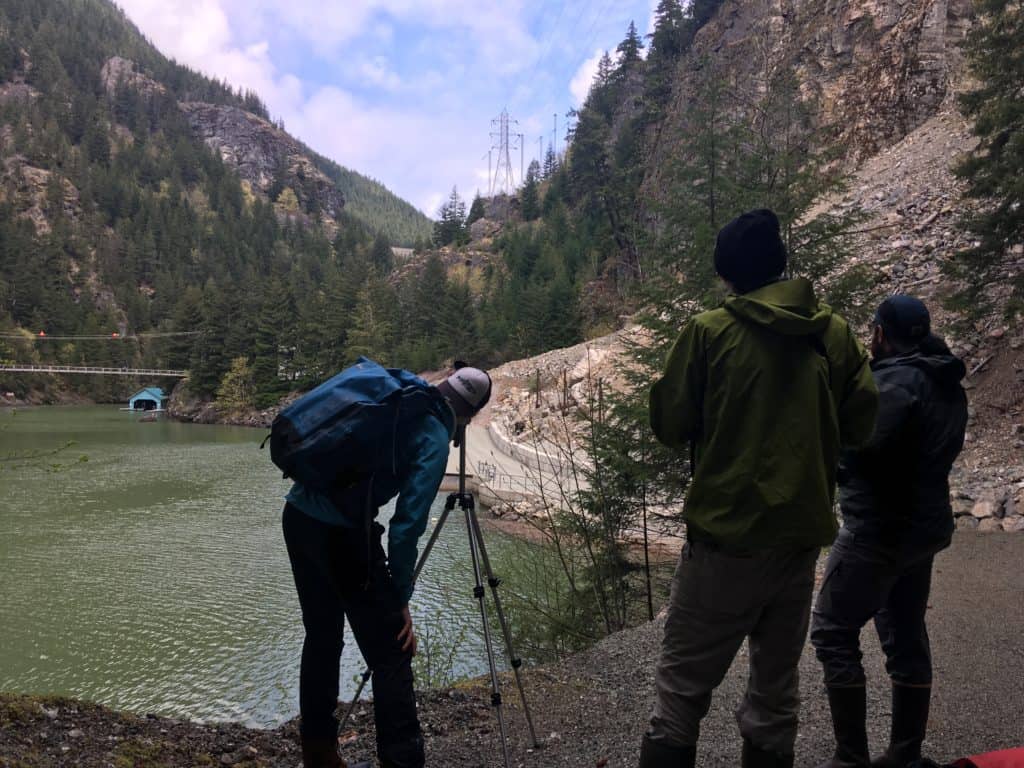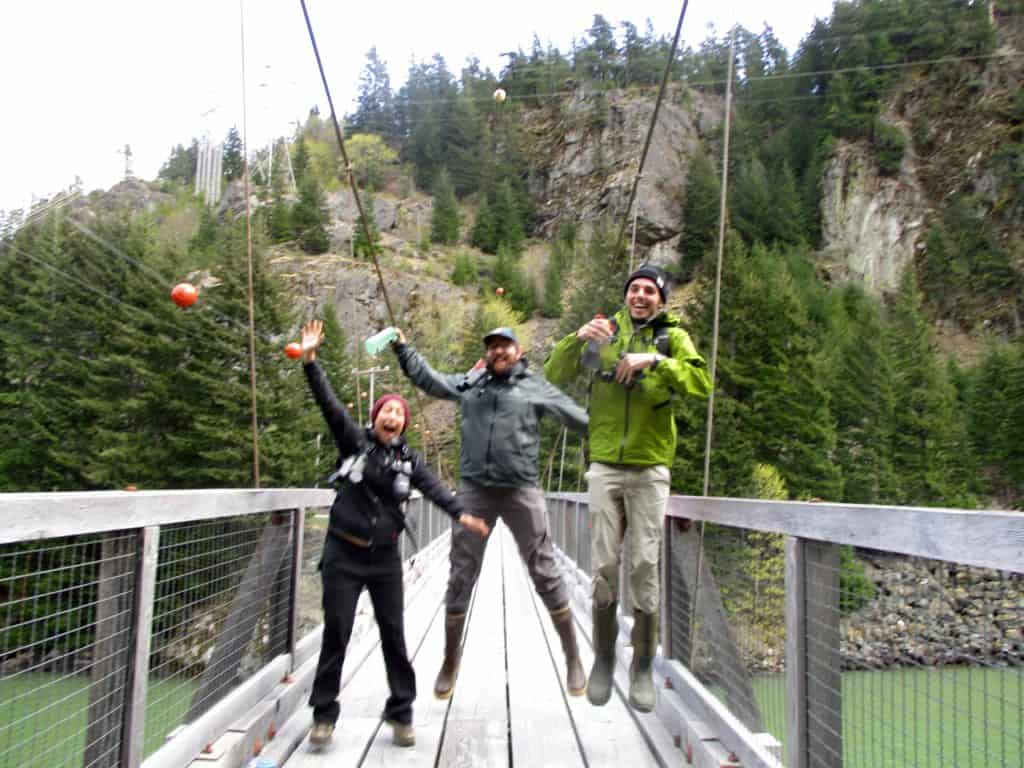
Perched on High Places: Dam Ospreys
With the changing of seasons, Osprey are returning to their home of the North Cascades, to begin life anew. While taking advantage of the warm, rainless days, graduate students Tanner Johnson, Zoe Wadkins and Marissa Bluestein decided to take the Diablo Lake Trail in pursuit of adventure. Scanning the sky during a snack break at the Ross Lake overlook, a flash of brown caught Zoe’s eye. She followed the fast flying bird with her binoculars and witnessed it land on top of a nearby power tower. Noticing additional movement next to the perched osprey, she focused her binoculars and was surprised to see a nest occupied by an additional bird. Realizing binoculars were not enough to fully experience the osprey’s majesty, our group packed up our bags and hit the trail in hopes of coming back with a spotting scope.

The next day accompanied by aspiring birder, Nate Trachte, we loaded canoes up with the essentials: snacks, layers and a spotting scope. Pushing off from the shores of Diablo Lake, Colonial and Pyramid Peak were shrouded in mist.

Clouds of big-leaf maple pollen wafted over the water as we paddled northeast toward Ross Dam. Continuing our paddle, the waters of Diablo Lake started to turn from dark green to emerald signifying the transition from winter to spring due to presence of glacial flour in the lake. Come July the lake will have turned turquoise from an increase in glacial flour as the sun refracts off glacially tilled rock particles suspended in the water. Spotted along the cliff sides were a multitude of newly melted cascading waterfalls.
After paddling 3 miles we arrived at the Seattle City Light dock. Eager to observe our avian neighbors we quickly ascended the gravel road leading to Ross Dam, which strategically would place us in sight of the nest. Rufous hummingbirds flitted amongst the Red-flowering currant, that calls them back each year to the Upper Skagit.

Setting our scope on the nest we observed the classic brown and white feather patterns of two adult osprey. For approximately an hour we witnessed these two birds of prey remain stationary in their nest providing us with a perfect opportunity to study their relational behaviors. Zoe observed one of the osprey’s securing their nest by removing loose sticks and weaving them into other areas. Of the two birds one seemed to be more stationary than the other, never getting up to perch, but always crouching or sitting in the nest.

Hoping to gain a different perspective we gathered our gear and walked to a nearby suspension bridge at the farthest northern point of Diablo Lake. Noticing that the diurnal afternoon wind was starting to pick up, we opted to look through binoculars instead of the spotting scope. With this new vantage point, the ospreys behavior wasn’t markedly different, so we started to make the journey back to the canoes, but not before jumping on the bridge to make it sway to and fro.

Portaging away from the Ross Lake dock the time was close to 3:30pm and the water was strikingly choppy even in the narrow canyon of upper Diablo Lake. By the time we were at the base of Colonial and Pyramid peaks, whitecaps were readily crashing and we often found ourselves at the mercy of the water’s sizeable wake. Hugging the leeward shore, we struggled to make any headway as we braved a headwind estimated at 15 knots. Finally, salvation appeared in the form of the North Cascades Environmental Learning Center and the dock welcomed us with open arms.

Celebrating our first adventures of the season and our appreciation for friendship, we returned our canoe to the beach. We then returned our canoe gear to the shed and our bodies to the dining hall, where we gathered for a hot meal and an in-depth conversation about our naturalist findings.
Interesting facts about Osprey
After our adventure, we spent time on the internet, in search of osprey facts and information. According to BirdWeb, an extension of the Seattle Audubon Society, we found out that:
- The osprey is the only species in its family, and it is found worldwide.
- The osprey’s talons are uniquely adapted for catching and carrying fish: their surfaces are rough, and their toes can be held with three forward and one back, or with two forward and two back, an arrangement seen in owls but not in other diurnal raptors.
- The osprey is highly specialized for eating fish and does not stray from this diet unless necessary. When it catches a fish, the osprey usually flies with it held headfirst.
- They will reuse nests year after year and continue to add sticks each year, ending up with a huge nest. Nests may be more than seven feet across and over five feet deep.
- The female typically lays 3 eggs, although clutch sizes between 2 and 4 eggs are normal. Both members of the pair incubate the eggs for 38-43 days.
- Osprey suffered great declines in the past century as a result of DDT and other eggshell-thinning pesticides. Since the ban of DDT in 1972, the osprey has made, and continues to make, a strong comeback in much of North America. Range expansion into formerly occupied areas has been slow due to their strong philopatry to nesting areas. Artificial nest platforms have significantly increased nesting in many areas. The Breeding Bird Survey has reported a significant increase in the osprey population in Washington.

